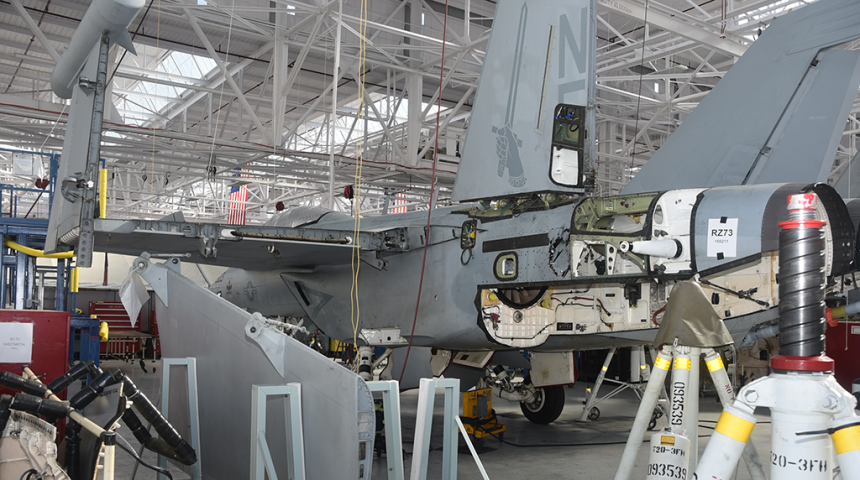An EA-18G of VAQ-136 was also damaged in the F-35C crash on USS Carl Vinson in South China Sea, the U.S. Navy says.
As we have reported in detail, an F-35C of Strike Fighter Squadron (VFA) 147 crashed on the flight deck of USS Carl Vinson and sunk in the South China Sea on Jan. 24, 2022. Seven crew members were injured when the accident occurred. The pilot of the F-35C ejected from the aircraft safely as it went into the water. In the days after the crash, a photo of the F-35C floating in the sea was leaked online, immediately followed by a video shot from the fantail and showing the last seconds before the touchdown. Then, a few days later, another clip was leaked online and posted on Reddit, showing both the PLAT camera video and another point of view from the aircraft carrier’s island.
The clip showed the Lightning II coming in with a rapidly increasing sink rate just before the touchdown, which prompted the Landing Signal Officer (LSO) or “Paddles” to start screaming on the radio “power” and then “wave off, wave off” to instruct the pilot to abort the landing and go around immediately.
The next chilling moments, showed a ramp strike or a very short and heavy landing: the aircraft hit the ship very hard, with the impact shredding off the main landing gear and causing the F-35 to bounce on the deck and hitting it nose-first, before starting to skid sideways while engulfed in flames.
Interestingly, the U.S. Navy has just made public for the first time that a Growler was also damaged, in the aft fuselage under the vertical tail, in the flight deck incident: according to a NAVAIR release dated Apr. 18, 2022, an EA-18G assigned to Electronic Attack Squadron (VAQ) 136, got the S9 skin in between the Y631 and Y645 formers (fuselage structure) punctured on the flight deck of USS Carl Vinson following the F-35C ramp strike.
While, the mishap airframe was recovered at a depth of two miles, using a series of cranes and a remotely operated submarine that attached cables to the F-35C (mainly to prevent some foreign actors to put their hands on what may have survived of the 5th generation aircraft), the EA-18G was sent to FRCSW (Fleet Readiness Center Southwest) at NASNI (Naval Air Station North Island), California, for domestic repairs.
“Because of the command’s investments in the latest maintenance and restoration technologies and systems, the estimated repair time will be approximately 50 percent sooner than purchasing the Growler’s components from the aircraft’s original manufacturer, Boeing.”
Therefore, the damaged Growler was inducted by Fleet Readiness Center Southwest’s (FRCSW) on Feb. 15, 2022, as an in-service repair (ISR), or a repair that is handled outside of scheduled maintenance.
“The repair plan is to remove the vertical tail in order to remove the S9 and S10 skins. We will replace the S9 skin and are hoping to save the S10 skin after evaluating it with a non-destructive inspection (NDI),” Ehren Terbeek, F/A-18 Legacy and E/F program manager said.
“We will need to NDI the Y631 former to verify that there is no crack, put the skins back on and place the vertical tail back on. If we do not have to replace the Y631 former or the S10 skin it should be around 4,500 manhours or about nine months.”
Terbeek said that the command will manufacture the Y645 former using its Flexible Manufacturing Cell (FMC) in Building 472, at NASNI (NAS North Island), California. It will be the first Growler part to be made on the FMC. The latter, the first of its kind, is comprised of six computer numerically controlled (CNC) five-axis machines and a pallet system which are made by DMG-Mori and Fastems, respectively. The FMC’s fixturing and preprogrammed parts were initially designed to support F/A-18 Hornet fighter and the E-2/C-2 airframe landing gear.
The CNC machines are capable of milling, turning and grinding within one machine and can be used on parts and components made of aluminum, steel and titanium.
The Growler’s former that needs to be manufactured is made of aluminum: it should take about three weeks and a total cost of 208K USD to manufacture the part. “Of that amount about $107,000 would be for non-recurring charges for modeling, programming and prove-out due to the fact this is the first time it is being manufactured; plus material is $23,906,” Terbeek said.









